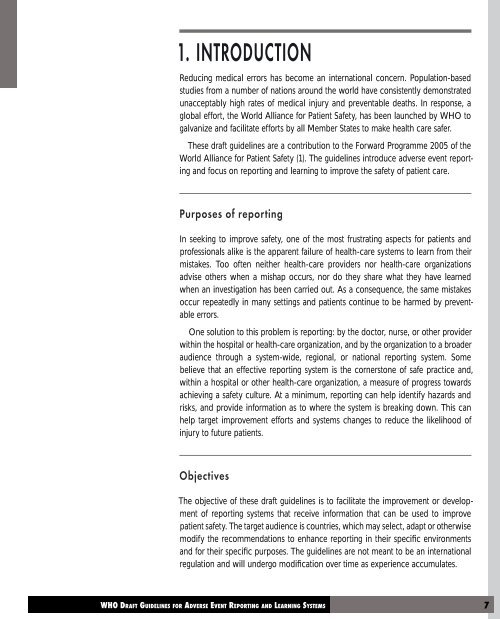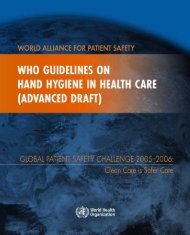Adverse event reporting.pdf
Adverse event reporting.pdf
Adverse event reporting.pdf
Create successful ePaper yourself
Turn your PDF publications into a flip-book with our unique Google optimized e-Paper software.
1. INTRODUCTION<br />
Reducing medical errors has become an international concern. Population-based<br />
studies from a number of nations around the world have consistently demonstrated<br />
unacceptably high rates of medical injury and pr<strong>event</strong>able deaths. In response, a<br />
global effort, the World Alliance for Patient Safety, has been launched by WHO to<br />
galvanize and facilitate efforts by all Member States to make health care safer.<br />
These draft guidelines are a contribution to the Forward Programme 2005 of the<br />
World Alliance for Patient Safety (1). The guidelines introduce adverse <strong>event</strong> <strong>reporting</strong><br />
and focus on <strong>reporting</strong> and learning to improve the safety of patient care.<br />
Purposes of <strong>reporting</strong><br />
In seeking to improve safety, one of the most frustrating aspects for patients and<br />
professionals alike is the apparent failure of health-care systems to learn from their<br />
mistakes. Too often neither health-care providers nor health-care organizations<br />
advise others when a mishap occurs, nor do they share what they have learned<br />
when an investigation has been carried out. As a consequence, the same mistakes<br />
occur repeatedly in many settings and patients continue to be harmed by pr<strong>event</strong>able<br />
errors.<br />
One solution to this problem is <strong>reporting</strong>: by the doctor, nurse, or other provider<br />
within the hospital or health-care organization, and by the organization to a broader<br />
audience through a system-wide, regional, or national <strong>reporting</strong> system. Some<br />
believe that an effective <strong>reporting</strong> system is the cornerstone of safe practice and,<br />
within a hospital or other health-care organization, a measure of progress towards<br />
achieving a safety culture. At a minimum, <strong>reporting</strong> can help identify hazards and<br />
risks, and provide information as to where the system is breaking down. This can<br />
help target improvement efforts and systems changes to reduce the likelihood of<br />
injury to future patients.<br />
Objectives<br />
The objective of these draft guidelines is to facilitate the improvement or development<br />
of <strong>reporting</strong> systems that receive information that can be used to improve<br />
patient safety. The target audience is countries, which may select, adapt or otherwise<br />
modify the recommendations to enhance <strong>reporting</strong> in their specific environments<br />
and for their specific purposes. The guidelines are not meant to be an international<br />
regulation and will undergo modification over time as experience accumulates.
















